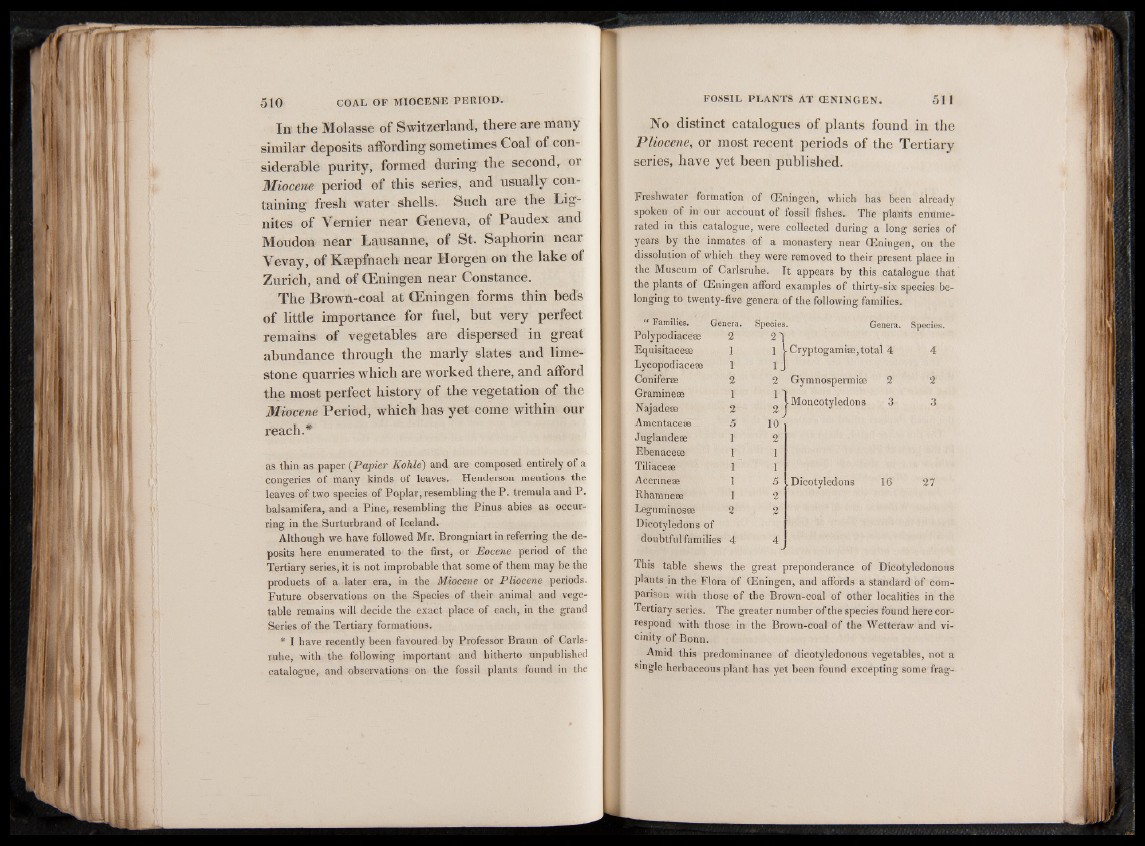
In the Molasse of Switzerland, there are many
similar deposits affording sometimes Coal of considerable
purity, formed during the second, or
Miocene period of this series, and usually containing
fresh water shells. Such are the Lignites
of Vernier near Geneva, of Paudex and
Moudon near Lausanne, of St. Saphorin near
Vevay, of Ksepfnach near Horgen on the lake of
Zurich, and of (Eningen near Constance.
The Brown-coal at CEningen forms thin beds
of little importance for fuel, but very perfect
remains of vegetables are dispersed in great
abundance through the marly slates and limestone
quarries which are worked there, and afford
the must perfect history of the vegetation of the
Miocene Period, which has yet come within our
reach.*
as thin as paper (Papier Kohle) and are composed entirely of a
congeries of many kinds of leaves. Henderson mentions the
leaves of two species of Poplar, resembling the P. tremula and P .
balsamifera, and a Pine, resembling the Pinus abies as occurring
in the Surturbrand of Iceland,
Although we have followed Mr. Brongniart in referring the deposits
here enumerated to the first, or Eocene period of the
Tertiary series, it is not improbable that some of them may be the
products of a later era, in the Miocene or Pliocene periods.
Future observations on the Species of their animal and vegetable
remains will decide the exact place of each, in the grand
Series of the Tertiary formations.
* I have recently been favoured by Professor Braun of Carls-
ruhe, with the following important and hitherto unpublished
catalogue, and observations on the fossil plants found in the
No distinct catalogues of plants found in the
Pliocene, or most recent periods of the Tertiary
series, have yet been published.
Freshwater formation of (Eningen, which has been already
spoken of in our account of fossil fishes. The plants enumerated
in this catalogue, were collected during a long series of
years by the inmates of a monastery near CEningen, on the
dissolution of which they were removed to their present place in
the Museum of Carlsruhe. It appears by this catalogue that
the plants of CEningen afford examples of thirty-six species belonging
to twenty-five genera of the following families.
" Families. Genera. Species. Genera. Species
Polypodiaceæ 2
Equisitaceæ 1 i 1- Cryptogamioe, total 4 4
Lycopodiaceæ 1 i j
Coniferæ 2 2 Gymnospermiæ 2 2
Gramineæ 1 F
Najadeæ I Moncotyledons 3 3
2 2
Amentaceæ 5 10-
Juglandeæ 1 2
Ebenaceæ 1 1
Tiliaceæ ] 1
Acerineæ I 5 . Dicotyledons 16 2 7
Rhamneæ 1 2
Leguminosæ 2 2
Dicotyledons of
doubtful families 4 4
This table shews the great preponderance of Dicotyledonous
plants in the Flora of CEningen, and affords a standard of comparison
with those of the Brown-coal of other localities in the
Tertiary series. The greater number of the species found here correspond
with those in the Brown-coal of the Wetteraw and vicinity
of Bonn.
Amid this predominance of dicotyledonous vegetables, not a
single herbaceous plant has yet been found excepting some frag